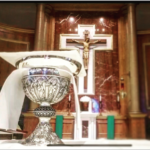Many persons who want to join the Catholic Church have already been baptized in another Christian Church. They will not be rebaptized. They will follow steps adapted to the particular needs and concerns of Christians from another faith tradition.
First Step: How someone comes to consider joining the Catholic Church is unique to each individual. Years of marriage to a Catholic spouse, conversations with a Catholic friends, students or coworkers, or even something written or viewed in the media can move an adult or child toward membership in the Catholic Church. Informally, this can go on for years! Return to Top of Page Return to Index
At some point, the person may contact a Catholic parish and begin to meet with others who are also inquiring about the Catholic faith. With the Welcome Team, they will take time to tell their own stories and connect them with the faith stories found in scripture.
Some of the inquirers become firm in their desire for initiation and decide that they would like to begin more formal study of the teachings and practices of the Catholic Church. They are admitted into the next step through a special ceremony called the Rite of Acceptance into the Order of Catechumens. In this ritual, the Church symbolically claims these men and women, boys and girls for Christ by signing them with the cross. This is the first time that the inquirers publicly declare their faith before the parish community. A sponsor accompanies each inquirer. Sponsors may be chosen by the individual or provided by the parish. Sponsors provide support and companionship for the rest of the R.C.I.A. process.
After this rite, the inquirers are called catechumens. This name indicates that they are learning about Jesus and deepening their knowledge of the scriptures and teachings of the Church. They are beginning to accept Catholic tradition and practices.
Even though they have not yet received the sacraments, the catechumens can participate in works of service in the parish. They also have a right to be married in the Church and to receive a Christian burial.
The time spent as a catechumen will vary from person to person. The bishops of the United States have suggested that this Catechumenate period is to last for at least one year.
The period of the Catechumenate ends when the catechumens discern, with the help of their sponsors and the parish Welcome Team, that God is calling them to receive the sacraments of initiation (baptism, confirmation, and first Eucharist) at the next Easter Vigil. Before they can be initiated, they must be officially called to the sacraments by the bishop. The Rite of Election is celebrated on the First Sunday of Lent in the diocesan cathedral.
The Rite of Election marks the end of the Catechumenate period. The catechumens are now called the elect. The weeks of Lent are a time of intense prayer as the elect prepare themselves to celebrate the Resurrection of the Lord at Easter and to receive the sacraments of initiation.
On the Sundays of Lent, the elect are prayed for in a special way to help them prepare more fully for the sacraments. The sponsors continue to accompany the elect in church and support them in their Lenten preparations.
- Fourth Step: Initiation and Mystagogia
On Holy Saturday, the parish assembles for the Easter Vigil. The Church has always recognized that in baptism we die to sin in Christ’s death so that we may rise to new life with him. The Easter Vigil is the primary celebration of the Lord’s Resurrection and is, therefore, the most appropriate occasion for the elect to celebrate their baptism, confirmation and first Eucharist.
For the newly initiated, now called neophytes, the time between Easter and Pentecost is a special opportunity to reflect on the commitment which they have made to the Lord, to the Church, and to the local parish community. This time of unfolding the meaning of the initiation sacraments is called Mystagogia. The Sunday scripture readings, which explain the meaning of the resurrection and of baptism, have special meaning for these new Catholics. During this season, the bishop may gather the neophytes for a special celebration called the Mass of the Neophytes.
The journey of faith lasts a lifetime. The weeks after Easter are a time for new Catholics to seek out their place in the parish community. Other parishioners can reach out to welcome them, helping them to get involved and feel at home.
If you know someone who might like to begin journeying with us in faith, please invite him or her to come with you to St. Boniface to celebrate the liturgy. Give them a bulletin to read or some of the pamphlets about our community found at the side windows or in the vestibule of the church. Direct them to this Website to learn more about our Parish. Contact Fr. Bob at 676-0676 or send email to stbonpastor@gmail.com.
Pages: 1 2









Speak Your Mind